|
(11) | EP 0 265 052 B1 |
| (12) | EUROPEAN PATENT SPECIFICATION |
|
|
| (54) |
Process for preparing fluoroaliphatic ether-containing carbonyl fluoride compositions Verfahren zur Herstellung von fluoraliphatischen ätherhaltigen Carbonylfluoridzusammensetzungen Procédé de préparation de compositions des fluorures de carbonyle contenant des éthers fluoroaliphatiques |
|
|
|||||||||||||||||||||||||||||||
| Note: Within nine months from the publication of the mention of the grant of the European patent, any person may give notice to the European Patent Office of opposition to the European patent granted. Notice of opposition shall be filed in a written reasoned statement. It shall not be deemed to have been filed until the opposition fee has been paid. (Art. 99(1) European Patent Convention). |
[0001] This invention relates to a process for preparing fluoroaliphatic ether-containing carbonyl fluoride compositions.
[0002] The preparation of perfluoroalkoxypropionic acid fluorides by reaction of hexafluoropropylene oxide,
with perfluorocarboxylic acid fluorides in the presence of various catalysts is known. U.S. Patent No. 3,250,808 (Moore et al.) discloses the reaction of hexafluoropropylene oxide with itself, fluoroalkanoic acid fluorides, or fluoroalkanones using various catalyst systems. The catalysts employed are activated charcoal, ionizing radiation, monovalent metal fluorides, particularly alkali metal fluorides, quaternary ammonium fluorides and alkali metal perfluoroalkoxides. The metal fluorides may be mixed with other alkali metal halides, e.g. lithium chloride/cesium fluoride, lithium chloride/potassium fluoride, and lithium bro- mide/potassium fluoride. U.S. Patent No. 3,311,658 (Warnell) discloses the use of alkali metal fluorides, quaternary ammonium fluorides, silver fluorides, and alkali metal perfluoroalkoxides as catalysts. British Patent No. 1,529,514 (duPont) discloses the use of sulfonium halides and complexes thereof as catalysts for the reaction of hexafluoropropylene oxide with fluorinated carbonyl compounds. U.S. Patent No. 4,118,421 (Martini) discloses N,N,N',N'-tetrasubstituted difluorodiaminomethanes and U.S. Patent 4,035,388 (Martini) discloses tris(dialkylamino)difluorophosphoranes as catalysts for the reaction of hexafluoropropylene oxide with perfluorocarboxylic acid fluorides and perfluorocarbonyl compounds, respectively. All of these catalysts serve to promote the formation of the perfluorinated alkoxide ion which is the species which undergoes reaction with the hexafluoropropylene oxide. It has also been reported [Izv. Akad. Nauk SSSR, Ser. Khim. 1891 (1983)] that the potassium halide salts potassium fluoride, potassium chloride, potassium bromide, and potassium iodide catalyze the oligomerization of hexafluoropropylene oxide, the use of the potassium fluoride resulting in the formation of hexafluoropropylene oxide oligomers up to the hexamer and the use of the potassium iodide resulting in the formation of mainly dimer and trimer.
[0003] This invention provides a process for preparing fluoroaliphatic ether-containing carbonyl fluoride compositions comprising reacting hexafluoropropylene oxide,
with a fluorinated carbonyl compound selected from fluorinated ketone and fluorinated acyl fluorides in the presence of at least one catalyst selected from potassium iodide, potassium bromide, cesium iodide, cesium bromide, rubidium iodide, and rubidium bromide.
[0004] Suitable reactive fluorinated carbonyl compounds useful in the process of the invention include those which can be represented by the general formula
where ? and R2 are independently: F; fluoroalkyl groups, R f, which are substantially perfluorinated and can be linear or branched, and which can contain H, CI or Br atoms and can contain catenary oxygen and/or trivalent nitrogen hetero atoms bonded only to carbon atoms of the skeletal chain, such hetero atoms providing stable linkages between fluorocarbon portions of the chain; fluorosulfonyl substituted perfluoroalkyl groups; fluorocarbonyl groups; fluorocarbonyl substituted perfluoroalkyl groups; alkoxycarbonyl substituted perfluoroalkyl groups; or R1 and R2 together with the
group can form a 4- to 7- membered ring; each of R1 and R2 having no more than 20 carbon atoms.
[0005] A subclass of the fluorinated carbonyl compounds useful in the process of this invention can be represented by the formula
where X is H, F, Cl, Br,
where R is a lower alkyl group having 1 to 8 carbon atoms, FS02-,
and R f, is a perfluoroalkylene group, having 1 to 20 carbon atoms, which is substantially perfluorinated and can be linear or branched, and which can contain one or more H, CI or Br atoms, and can contain catenary oxygen and/or trivalent nitrogen hetero atoms bonded only to carbon atoms of the skeletal chain, such hetero atoms providing stable linkages between fluorocarbon portions of the chain.
[0006] Fluorinated carbonyl compounds which can be used in the process of the invention include COF2, FCOCOF, CF3COF, C2FsCOF, n-C3F7COF, i-C3F7COF, C2FsOCF2COF, C3F70C(CF3)FCOF, C3F7O[C(CF3)FCF2O]3C(CF3)FCOF, C2FsOCF2CF20CF2COF, H(CF2)6COF, BrCF2COF, CICF2COF, FS02(CF2)3COF, CF3COCF3, HCF2COCF2H, FOCCF2CF2COF, FOC-CF2CF2COOCH3, CF3COCF20C(CF3)FCOOCH3, CH3S02CF2CF2COCF3, CF3CFHCOF, C3F7OC(CF2CI)FCOF, C7F15COF, C3F70C(CF2CI)FCF20C(CF2CI)FCOF, (C2Fs)2NCF2CF2COF, FOCC(CF3)FOCF2CF2COOCH3, FOCC(CF3)FOCF2CF2COOC2H5,
[0007] The fluoroaliphatic ether-containing carbonyl fluoride compositions produced by the process of this invention comprise mixtures of compounds represented by the formula
where R f is as defined above and p is zero or a number up to about 10 or higher.
[0008] Representative reaction schemes illustrative of the process of the invention are shown below. In each scheme R f is as defined above, M is K, Rb or Cs, X is bromide or iodide, and p is a number from 1 to about 10.
[0009] The process of this invention is preferably carried out in a polar organic solvent. Suitable solvents include aliphatic ethers such as diglyme, triglyme, and tetraglyme, with diglyme (diethylene glycol dimethyl ether) being generally more preferred, although the higher boiling point solvents, e.g., tetraglyme, are more preferred where recovery of low boiling point fluoroaliphatic ether-containing carbonyl fluoride compounds from the reaction product is required. Other solvents such as acetone or acetonitrile may also be employed. Reaction temperatures can vary widely, e.g., from about -80° to 100°C, preferably -30 to 60°C. Reaction time is generally from several minutes to about 50 hours depending on the scale of the reaction, with larger scale reactions requiring longer times. The reaction is generally carried out at atmospheric pressure, although higher pressure can be used, and requires no special equipment. To perform the reaction, the solvent and the fluorinated carbonyl compounds are charged to the reaction vessel and the catalyst is then added followed by addition of the hexafluoropropylene oxide, or the solvent and catalyst are charged to the reaction vessel and the fluorinated carbonyl compound is added and then the hexafluoropropylene oxide is added. Generally, processes for producing carbonyl fluoride compositions must be carried out under scrupulously anhydrous conditions, i.e., less than 100 ppm water, to prevent hydrolysis of the transitory intermediate perfluoroalkoxide,
which would result in the formation of
Surprisingly, the process of the present invention need only be carried out under substantially anhydrous conditions, i.e., less than 2000 ppm, more preferably less than 1000 ppm water.
[0010] The preferred catalysts are potassium iodide and potassium bromide. Potassium chloride alone does not catalyze the reaction, although it will give a small yield of the desired products when a crown ether such as 18-crown-6 is employed as a co-catalyst.
[0011] The fluoroaliphatic ether-containing carbonyl fluoride compositions resulting from the reaction can be recovered from the reaction product mixture by phase separation followed by distillation.
[0012] The yields of the fluoroaliphatic ether-containing carbonyl fluoride composition from the reaction employing the catalysts of this invention are high, e.g., generally 50% or more based on the fluorinated carbonyl compound when the catalyst is potassium iodide or bromide, such yields frequently superior to those obtained with more commonly utilized catalysts such as cesium fluoride. The composition of the recovered fluoroaliphatic ether-containing carbonyl fluoride composition is substantially the same as that obtained by using cesium fluoride as the catalyst, although when potassium bromide is used as the catalyst there is a small amount of bromine-containing material in the final product.
[0013] In admixture with the fluoroaliphatic monoether compounds (Scheme 1, where p is 1), there are fluoroaliphatic polyether compounds which are formed by the addition of more units of hexafluoropropylene oxide, e.g., where p is 2 to 10 or higher. Under the appropriate conditions, e.g. when a higher molar ratio of hexafluoropropylene oxide to fluorinated carbonyl reactant is used, the polyether materials may become the major products.
[0014] The concentration of the catalyst used is, functionally stated, a catalytic amount, and this amount can be empirically determined. Generally that amount need not exceed about 12 mole percent based on the fluorinated carbonyl compound when potassium iodide is the catalyst. With potassium bromide, it is occasionally necessary to use somewhat larger amounts of catalyst ranging up to 100 mole percent based on the fluorinated carbonyl compound. The use of higher amounts of catalyst than that determined empirically is not detrimental to the reaction but offers no particular advantages.
[0015] The fluoroaliphatic ether-containing carbonyl fluorides produced by the process of this invention are useful intermediates for the preparation of many derivatives, e.g., carboxylic acids and their salts, esters, amides, alcohols, acrylates, vinyl ethers, polymers, etc., as described in U.S. Patents No. 3,250,808 (Moore et al.) and No. 3,699,156 (Holland et al.). These derivatives have utility for various applications, such as surfactants, lubricants, heat transfer and cooling fluids, hydraulic fluids and vapor phase heating.
[0016] To further illustrate this invention, the following nonlimiting examples are provided. In these examples, amounts are in weight percent unless otherwise indicated. All products had physical and analytical properties which were fully consistent with their structure and agreed with the data from products prepared by an alternate route. Gas chromatographic (GC) analysis of the reaction products, after conversion to the methyl esters, using a 3 meter OV101 column, gave baseline separation of the starting materials and the fluoroaliphatic ether products. Infrared (IR) spectral analysis of the products showed the characteristic carbonyl fluoride stretch at 5.22 microns. Fluorine nuclear magnetic resonance (19F NMR) analysis was occasionally complicated by the presence of isomers and non-carbonyl-containing impurities present in the original starting acid fluorides, as well as some overlap in the 75-85 ppm range, but showed the characteristic -COF fluorine at +26 ppm downfield from the internal CFCI3 standard. Mass spectral (MS) analysis was also carried out in some cases. Additional confirmation of the aliphatic ether-containing carbonyl fluoride products was obtained by conversion to the corresponding perfluorinated vinyl ether using standard procedures as described in U.S. Patent No. 3,250,808 (Moore et al.) Yields were based on GC area percentages corrected for non-hexafluoropropylene oxide derived materials.
Example 1
[0017] Potassium iodide (3.07 g, 0.018 mole) which had been vacuum dried was added to diglyme (42 g, distilled from sodium benzophenone ketyl) contained in a 250 ml, 3-necked, round bottom flask equipped with a Dry IceTM-acetone condenser, an overhead stirrer, and a gas inlet, and cooled to -20°C. Tetrafluorosuccinyl fluoride, FCOCF2CF2COF (40 g of 75% purity, 0.15 mole), was added and the mixture stirred for 45 minutes. Hexafluoropropylene oxide (50 g of 80% purity, 0.30 mole) was added over 45 minutes. The reaction mixture was separated. The lower fluorochemical phase contained: 35% FOC(CF2)3OCF(CF3)COF and 49% FOCCF(CF3)O(CF2)4OCF(CF3)COF, a yield of 95% based on tetrafluorosuccinyl fluoride. The remainder (16%) of the fluorochemical phase was starting material and a small amount of hexafluoropropylene oxide oligomers.
Example 2
[0018] Potassium iodide (1.7 g, 0.01 mole) and diglyme (50 g) were combined as in Example 1 and cooled to - 20°C. Trifluoroacetyl fluoride, CF3COF (10 g, 0.086 mole), was added as a gas over a period of about 10 minutes with stirring and the mixture was further stirred for 20 minutes. Hexafluoropropylene oxide (17.9 g of 80% purity, 0.086 mole) was added and the mixture stirred until reflux from the Dry Ice condenser had ceased. The fluorochemical product layer was separated and reacted with methanol-BFs at 0-5°C for 10 minutes to convert the volatile acyl fluorides to the corresponding methyl ester. The product contained about 100% fluoroaliphatic ether-containing methyl ester compounds, C2F50[CF(CF3)CF20] xCF(CF3)CO2CH3, with the product distribution being x=0 (49%), x=1 (45%) and x=2 (6%). Yield of the product was 56% based on CFsCOF. Trace amounts of hexafluoropropylene oxide oligomers were also formed.
Example 3
[0019] Potassium iodide (4.5 g, 0.027 mole) and diglyme (60 g) were combined as in Example 1 and cooled to - 20°C. Heptafluorobutyryl fluoride, C3F7COF (70.9 g of 43% purity, 0.14 mole) was added and the mixture stirred. Hexafluoropropylene oxide (58.5 g of 80% purity, 0.28 mole) was added over 30 minutes. The reaction mixture was allowed to warm to about 25°C over a five-hour period and the resulting product was found to contain 91% fluoroaliphatic ether-containing carbonyl fluoride compounds, C4Fs0[CF(CFs)CF20] xCF(CF3)COF, with the product distribution being x=0 (23%), x=1 (54%) and x=2 (23%), in a nearly quantitative yield based on C3F7COF. Nine percent of the fluorochemical product was hexafluoropropylene oxide oligomers.
Example 4
[0020] Using the procedure of Example 1, potassium iodide (2.55 g, 0.015 mole), diglyme (80 g) and per- fluoro(diethylaminopropionyl) fluoride, (C2Fs)2NCF2CF2COF, (100 g of 51% purity, 0.129 mole) were combined and stirred at 0°C for 45 minutes. Hexafluoropropylene oxide (28 g of 80% purity, 0.135 mole) was added and the mixture stirred for 4 hours and then slowly allowed to warm to about 25°C over a 2- hour period. The resulting two-phase reaction mixture was separated and the lower fluorochemical phase analyzed and found to contain 59% fluoroaliphatic ether-containing carbonyl fluoride compounds, (C2F5)2N(CF2)3O[CF(CF3)CF2O] xCF(CF3)COF, with the product distribution being x=0 (80%) and x=1 (20%), in a yield of 76% based on starting acyl fluoride. The remainder of the fluorochemical product was starting material and hexafluoropropylene oxide oligomers.
Example 5
[0021] Potassium iodide (1.2 g, 0.007 mole) and diglyme (50 g) were combined as in Example 1 and cooled to - 20°C. An extra condenser was placed on top of the first Dry Ice condenser and both were filled with Dry Ice-diethyl ether. Carbonyl fluoride, COF2 (5.0 g, 0.076 mole) was added as a gas. Hexafluoropropylene oxide (25.1 g, 0.15 mole) was added over a fifteen minute period. The resulting mixture was sti rred for two hours and the lower fluorochemical phase was then separated. For ease of analysis due to the volatility of the acyl fluoride, the product was converted to the methyl ester as in Example 2. GC-MS and 19F.NMR analysis of the reaction mixture showed the expected fluoroaliphatic ether-containing methyl ester compounds, CF30[CF(CF3)CF20] xCF(CF3)C02CH3, where x was 1 to 5, and an equal amount of hexafluoropropylene oxide oligomers.
Example 6
[0022] Potassium iodide (1.20 g, 0.007 mole) and diglyme (50 g) were combined as in Example 1 and cooled to - 20°C. Hexafluoroacetone (8.0 g, 0.048 mole) was condensed into the mixture and the suspension stirred for 25 minutes. Hexafluoropropylene oxide (20.0 g of 80% purity, 0.096 mole) was added over a period of 20 minutes and the resulting mixture stirred for two hours while slowly warming to about 25°C. The lower fluorochemical phase was separated to give 21.7 g of a mixture of fluoroaliphatic ether-containing carbonyl fluoride compounds, (CF3)2CFO[CF(CF3)CF20] xCF(CF3)COF, where x=0 to 3 and hexafluoropropylene oxide oligomers in a 4:1 mole ratio.
Example 7
[0023] Diglyme (92.5 kg) (Ansul E-141, Ansul Co.; water content 640 ppm) was charged into a 189 L refrigerated stainless steel reactor followed by the addition of potassium iodide (3.9 kg, 23.5 mole) (Mallinckrodt). The batch was cooled to -12°C and C3F7COF (77 kg of 51% purity, 181 mole) was added rapidly. The mixture was agitated for two hours at -12°C. Hexafluoropropylene oxide (77 kg, 464.9 mole) was subsequently added such that the temperature of the reaction did not exceed -12°C. After the addition of the hexafluoropropylene oxide was complete, the reactor was held for one hour at -18 to -12°C. The batch was then heated for 1 hour to 52°C to remove the lower boiling impurities. After cooling to 21°C over a 2 hour period, the bottom fluorochemical phase was separated to give 118 kg (80%) fluoroaliphatic ether-containing carbonyl fluoride compounds, C4F9O[CF(CF3)CF2O] xCF(CF3)COF, with the product distribution being x=0 (20%), x=1 (65%) and x=2 (15%), and 20% hexafluoropropylene oxide oligomers, C3F70[CF(CF3)CF20] xCF(CFa)COF, with the product distribution being x=0 (40%), x=1 (50%) and x=2 (10%). The mole percent yield of fluoroaliphatic ether-containing carbonyl fluoride compounds based on C3F7COF was 90% and based on hexafluoropropylene oxide was 82%.
Example 8
[0024] Potassium iodide (7.1 g, 0.043 mole) and diglyme (94g) were combined as in Example 1. 4-(Fluorosulfonyl)hexafluorobutyryl fluoride, F02S(CF2)3COF, (173g of 58% purity, 0.358 mole) was added at 25°C and the contents stirred for 30 minutes and then cooled to 0°C. Hexafluoropropylene oxide (151 g, 0.910 mole) was added over four hours with the bulk (120g) added within the first hour. After the reaction was complete, the phases were separated and the lower fluorochemical phase (290g) was analyzed and found to contain 64% fluoroaliphatic ether-containing carbonyl fluoride compounds, F02S(CF2)40[CF(CF3)CF20] xCF(CF3)COF, with the product distribution being x=0 (17%), x=1 (72%) and x=2 (11%), in a yield of 89% based on starting acid fluoride. The remainder of the fluorochemical phase (36%) was starting material.
1. A process for preparing fluoroaliphatic ether-containing carbonyl fluoride compounds
comprising reacting hexafluoropropylene oxide with a fluorinated carbonyl compound
selected from fluorinated ketone and fluorinated acyl fluorides in the presence of
at least one catalyst selected from potassium iodide, potassium bromide, cesium iodide,
cesium bromide, rubidium iodide, and rubidium bromide.
2. The process of claim 1 wherein said reaction is conducted in a polar organic solvent.
3. The process of claim 1 wherein said process is carried out under substantially
anhydrous conditions.
4. The process of claim 1 wherein said reaction is conducted at a temperature of about
-80°C to 100°C.
5. The process of claim 1 wherein said process further comprises recovering said fluoroaliphatic
ether-containing carbonyl fluoride compounds by phase separation followed by distillation.
6. The process of claim 1 wherein said fluorinated carbonyl compound is represented
by the formula

where R1 and R2 are independently F; fluoroalkyl groups, R f, which are substantially perfluorinated and can be linear or branched, and which can contain H, CI or Br atoms and can contain catenary oxygen and/or trivalent nitrogen hetero atoms bonded only to carbon atoms of the skeletal chain, such hetero atoms providing stable linkages between fluorocarbon portions of the chain; fluorosulfonyl substituted perfluoroalkyl groups; fluorocarbonyl groups; fluorocarbonyl substituted perfluoroalkyl groups; alkoxycarbonyl substituted perfluoroalkyl groups; or the R1 and R2 together with the

group can form a 4- to 7-membered ring; each of R1 and R2 having no more than 20 carbon atoms.
where R1 and R2 are independently F; fluoroalkyl groups, R f, which are substantially perfluorinated and can be linear or branched, and which can contain H, CI or Br atoms and can contain catenary oxygen and/or trivalent nitrogen hetero atoms bonded only to carbon atoms of the skeletal chain, such hetero atoms providing stable linkages between fluorocarbon portions of the chain; fluorosulfonyl substituted perfluoroalkyl groups; fluorocarbonyl groups; fluorocarbonyl substituted perfluoroalkyl groups; alkoxycarbonyl substituted perfluoroalkyl groups; or the R1 and R2 together with the
group can form a 4- to 7-membered ring; each of R1 and R2 having no more than 20 carbon atoms.
7. The process of claim 1. wherein said fluorinated carbonyl compound is represented
by the formula

where X is H, F, Cl, Br,

where R is lower alkyl, FS02-, or
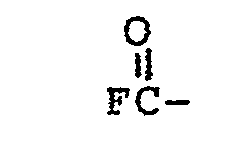
and R f' is a fluoroalkylene group, having 1 to 20 carbon atoms, which is substantially perfluorinated and can be linear or branched, and which can contain one or more H, Cl, or Br atoms, and can contain catenary oxygen and/or trivalent nitrogen hetero atoms bonded only to carbon atoms of the skeletal chain, such hetero atoms providing stable linkages between fluorocarbon portions of the chain.
where X is H, F, Cl, Br,
where R is lower alkyl, FS02-, or
and R f' is a fluoroalkylene group, having 1 to 20 carbon atoms, which is substantially perfluorinated and can be linear or branched, and which can contain one or more H, Cl, or Br atoms, and can contain catenary oxygen and/or trivalent nitrogen hetero atoms bonded only to carbon atoms of the skeletal chain, such hetero atoms providing stable linkages between fluorocarbon portions of the chain.
8. The process of claim 1 wherein said fluorinated carbonyl compound is COF2, FCOCOF, CFsCOF, C2FsCOF, n-C3F7COF, i-C3F7COF, C2F5OCF2COF, C3F7OC(CF3)FCOF, C3F3O[C(CF3)FCF2O]3C(CF3)FCOF, C2FSOCF2CF20CF2COF, H(CF2)6COF, BrCF2COF, CICF2COF, FSO2(CF2)3COF, CF3COCF3, HCF2COCF2H, FOCCF2CF2COF, FOC CF2CF2COOCH3, C7F15COF, CF3COCF2OC(CF3)FCOOCH3, CH3SO2CF2CF2COCF3, CF3CFHCOF, C3F7OC(CF2Cl)FCOF, C3F7OC(CF2Cl)FCF2OC(CF2Cl)FCOF, (C2F5)2NCF2CF2COF, FOCC(CF3)FOCF2CF2COOCH3, FOCC(CFs)FOCF2CF2COOC2Hs,
9. The process of claim 1 wherein said catalyst is potassium iodide or potassium bromide.
10. The process of claim 1 wherein said fluorinated carbonyl compound is tetrafluorosuccinyl
fluoride, trifluoroacetal fluoride, carbonyl fluoride, hexafluoroacetone, heptafluorobutyryl
fluoride, 4-(fluorosulfonyl)hexafluorobutyryl fluoride, or pentadecafluorooctanyl
fluoride and said catalyst is potassium iodide.
1. Verfahren zum Erzeugen von fluoroaliphatischen Ether enthaltenden Carbonylfluoridverbindungen,
in dem Hexafluoropropylenoxid in Gegenwart mindestens eines Katalysators, der aus
Kaliumjodid, Kaliumbromid, Cäsiumjodid Cäsumbromid- Rubidiumjodid und Rubidiumbromid
ausgewählt ist, mit einer fluorierten Carbonylverbindung umgesetzt wird, die aus fluoriertem
Keton und fluorierten Acylfluoriden ausgewählt ist.
2. Verfahren nach Anspruch 1, dadurch gekennzeichnet, daß die Reaktion in einem polaren
organischen Lösungsmittel durchgeführt wird.
3. Verfahren nach Anspruch 1, dadurch gekennzeichnet, daß das Verfahren unter im wesentlichen
wasserfreien Bedingungen durchgeführt wird.
4. Verfahren nach Anspruch 1, dadurch gekennzeichnet, daß die Reaktion bei Temperaturen
von etwa-80°C bis 100°C durchgeführt wird.
5. Verfahren nach Anspruch 1, dadurch gekennzeichnet, daß in dem Verfahren die fluoroaliphatischen
Ether enthaltenden Carbonylfluoridverbindungen durch Phasentrennung und darauffolgende
Destillation gewonnen werden.
6. Verfahren nach Anspruch 1, dadurch gekennzeichnet, daß die fluorierte Carbonylverbindung
durch die Formel

dargestellt ist, in der R1 und R2 unabhängig voneinander F oder Fluoroalkylgruppen Rf sind, die im wesentlichen perfluoriert sind und die linear oder verzweigt sein können, H-, CI- oder Br-Atome enthalten können und kastenare Sauerstoff- und/oder dreiwertige Stickstoff-Heteroatome enthalten können, die nur mit Kohlenstoffatomen der Gerüstkette verbunden sind und stabile Bindungen zwischen Fluorokohlenstoffteilen der Kette bilden; ferner fluorosulfonylsubstituierte Perfluoroalkylgruppen; Fluorocarbonylgruppen; fluorocarbonylsubstituierte Perfluoroalkylgruppen; alkoxycarbonylsubstituierte Perfluoroalkylgruppen; oder die Glieder R1 und R2 zusammen mit der Gruppe

einen 4- bis 7-gliedrigen Ring bilden können und jedes der Glieder R1 und R2 nicht mehr als 20 Kohlenstoffatome besitzt.
dargestellt ist, in der R1 und R2 unabhängig voneinander F oder Fluoroalkylgruppen Rf sind, die im wesentlichen perfluoriert sind und die linear oder verzweigt sein können, H-, CI- oder Br-Atome enthalten können und kastenare Sauerstoff- und/oder dreiwertige Stickstoff-Heteroatome enthalten können, die nur mit Kohlenstoffatomen der Gerüstkette verbunden sind und stabile Bindungen zwischen Fluorokohlenstoffteilen der Kette bilden; ferner fluorosulfonylsubstituierte Perfluoroalkylgruppen; Fluorocarbonylgruppen; fluorocarbonylsubstituierte Perfluoroalkylgruppen; alkoxycarbonylsubstituierte Perfluoroalkylgruppen; oder die Glieder R1 und R2 zusammen mit der Gruppe
einen 4- bis 7-gliedrigen Ring bilden können und jedes der Glieder R1 und R2 nicht mehr als 20 Kohlenstoffatome besitzt.
7. Verfahren nach Anspruch 1, dadurch gekennzeichnet, daß die fluorierte Carbonylverbindung
durch die Formel

dargestellt ist, in der X die Bedeutung H, F, Cl, Br oder
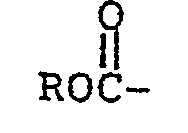
hat, wobei R ein niederes Alkyl, FS02- oder

ist, und Rf' eine Fluoroalkylengruppe ist, die 1 bis 20 Kohlenstoffatome hat und im wesentlichen perfluoriert ist, linear oder verzweigt sein kann, ein oder mehrere H-, CI- oder Br-Atome enthalten kann und katenare Sauerstoff- und/oder dreiwertige Stickstoff-Heteroatome enthalten kann, die nur mit Kohlenstoffatomen der Gerüstkette verbunden sind und stabile Bindungen zwischen Fluorokohlenstoffteilen der Kette bilden.
dargestellt ist, in der X die Bedeutung H, F, Cl, Br oder
hat, wobei R ein niederes Alkyl, FS02- oder
ist, und Rf' eine Fluoroalkylengruppe ist, die 1 bis 20 Kohlenstoffatome hat und im wesentlichen perfluoriert ist, linear oder verzweigt sein kann, ein oder mehrere H-, CI- oder Br-Atome enthalten kann und katenare Sauerstoff- und/oder dreiwertige Stickstoff-Heteroatome enthalten kann, die nur mit Kohlenstoffatomen der Gerüstkette verbunden sind und stabile Bindungen zwischen Fluorokohlenstoffteilen der Kette bilden.
8. Verfahren nach Anspruch 1, dadurch gekennzeichnet, daß die fluorierte Carbonylverbindung
COF2, FCOCOF, CF3COF, C2FsCOF, n-C3F7COF, i-C3F7COF, C2F5OCF2COF, C3F7OC(CF3)FCOF, C3F70[C(CF3)FCF20]3C(CF3)FCOF, C2FsOCF2CF2COF, H(CF2)6COF, BrCF2COF, CICF2COF, FS02(CF2)3COF, CF3COCF3, HCF2COCF2H, FOCCF2CF2COF, FOCCF2CF2COOCH3, C7F15COF, CF3COCF2OC(CF3)FCOOCH3, CH3SO2CF2COCF3, CFsCFHCOF, C3F7OC(CF2Cl)FCOF, C3F7OC(CF2Cl)FCF2OC(CF2Cl)FCOF(C2F5)2NCF2CF2COF, FOCC(CF3)FOCF2CF2COOCH3, FOCC(CF3)FOCF2CF2COOC2H5,

9. Verfahren nach Anspruch 1, dadurch gekennzeichnet, daß der Katalysator Kaliumjodid
oder Kaliumbromid ist.
10. Verfahren nach Anspruch 1, dadurch gekennzeichnet, daß die fluorierte Carbonylverbindung
Tetrafluorosuccinylfluorid, Trifluoroacetalfluorid, Carbonylfluorid, Hexafluoroaceton,
Heptafluorobutyrylfluorid, 4-(Fluorosulfonyl)hexafluorobutyrylfluorid oder Pentadecafluorooctanylfluroid
ist und der Katalysator Kaliumjodid ist.
1. Procédé de préparations de composés fluorure de carbonyle à fonctionnalité éther
fluoroaliphati- que, consistant à faire réagir de l'oxyde d'hexafluoropropylène avec
un composé carbonyle fluoré choisi parmi l'ensemble comprenant les cétones fluorées
et fluorures d'acyle fluorés, en présence d'au moins un catalyseur choisi parmi l'ensemble
comprenant l'iodure de potassium, le bromure de potassium, l'iodu- re de césium, le
bromure de césium, l'iodure de rubidium et le bromure de rubidium.
2. Procédé selon la revendication 1, dans lequel ladite réaction est mise en oeuvre
dans un solvant organique polaire.
3. Procédé selon la revendication 1, dans lequel ledit procédé est mis en oeuvre dans
des conditions essentiellement anhydres.
4. Procédé selon la revendication 1, dans lequel ladite réaction est mise en oeuvre
à une température d'environ -80°C à 100°C.
5. Procédé selon la revendication 1, dans lequel ledit procédé consiste en outre à
récupérer, par séparation de phases, puis distillation, lesdits composés fluorure
de carbonyle à fonctionnalité éther fluo- roaliphatique.
6. Procédé selon la revendication 1, dans lequel ledit composé carbonyle fluoré est
représenté par la formule

dans laquelle R1 et R2, indépendamment l'un de l'autre, représentent F; des groupes fluoroalkyle, Rf, qui sont essentiellement perfluorés et peuvent être à chaîne droite ou ramifiée, et qui peuvent contenir des atomes de H, CI ou Br et peuvent contenir des hétéroatomes d'oxygène caténaire et/ou d'azote trivalent liés uniquement aux atomes de carbone du squelette, ces hétéroatomes assurant des liaisons stables entre les fragments fluorocarbonés de la chaîne; des groupes perfluoroalkyle substitués par un ou plusieurs groupes fluorosylfonyle; des groupes fluorocarbonyle; des groupes perfluoroalkyle substitués par un ou plusieurs groupes fluorocarbonyle; des groupes perfluoroalkyle substitués par un ou plusieurs groupes alcoxycarbonyle; ou bien les radicaux R1 et R2, considérés avec le groupe
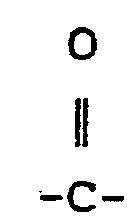
peuvent former un cycle de 4 à 7 sommets; chacun des radicaux R1 et R2 n'ayant pas plus de 20 atomes de carbone.
dans laquelle R1 et R2, indépendamment l'un de l'autre, représentent F; des groupes fluoroalkyle, Rf, qui sont essentiellement perfluorés et peuvent être à chaîne droite ou ramifiée, et qui peuvent contenir des atomes de H, CI ou Br et peuvent contenir des hétéroatomes d'oxygène caténaire et/ou d'azote trivalent liés uniquement aux atomes de carbone du squelette, ces hétéroatomes assurant des liaisons stables entre les fragments fluorocarbonés de la chaîne; des groupes perfluoroalkyle substitués par un ou plusieurs groupes fluorosylfonyle; des groupes fluorocarbonyle; des groupes perfluoroalkyle substitués par un ou plusieurs groupes fluorocarbonyle; des groupes perfluoroalkyle substitués par un ou plusieurs groupes alcoxycarbonyle; ou bien les radicaux R1 et R2, considérés avec le groupe
peuvent former un cycle de 4 à 7 sommets; chacun des radicaux R1 et R2 n'ayant pas plus de 20 atomes de carbone.
7. Procédé selon la revendication 1, dans lequel ledit composé carbonyle fluoré est
représenté par la formule

dans laquelle X est H, F, CI, Br,
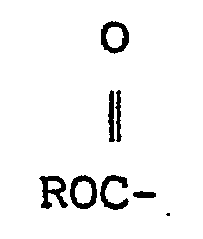
où R est un radical alkyle inférieur, FS02-, ou
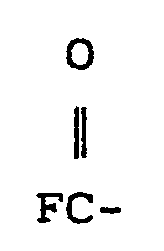
et Rf' est un groupe fluoroalkylène ayant de 1 à 20 atomes de carbone, qui est essentiellement perfluoré et peut être à chaîne droite ou linéaire, et qui peut contenir un ou plusieurs atomes de H, CI ou Br et peut contenir des hétéroatomes d'oxygène caténaire et/ou azote trivalent liés uniquement aux atomes de carbone du squelette, ces hétéroatomes assurant des liaisons stables entre les fragments fluorocarbonés de la chaîne.
dans laquelle X est H, F, CI, Br,
où R est un radical alkyle inférieur, FS02-, ou
et Rf' est un groupe fluoroalkylène ayant de 1 à 20 atomes de carbone, qui est essentiellement perfluoré et peut être à chaîne droite ou linéaire, et qui peut contenir un ou plusieurs atomes de H, CI ou Br et peut contenir des hétéroatomes d'oxygène caténaire et/ou azote trivalent liés uniquement aux atomes de carbone du squelette, ces hétéroatomes assurant des liaisons stables entre les fragments fluorocarbonés de la chaîne.
8. Procédé selon la revendication 1, dans lequel ledit composé carbonyle fluoré est
COF2, FCOCOF, CF3COF, C2FsCOF, n-C3F7COF, iso-C3F7COF, C2F50CF2COF, C3F70C(CF3)FCOF, C3F70[C(CF3)FCF20]3C(CF3)FCOF, C2FsOCF2CF20CF2COF, H(CF2)6COF, BrCF2COF, CICF2COF, FS02(CF2)3COF, CF3COCF3, HCF2COCF2H, FOCCF2CF2COF, FOCCF2CF2COOCH3, C7F15COF, CF3COCF20C(CF3)FCOOCH3, CH3S02CF2CF2COCF3, CF3CFHCOF, C3F7OC(CF2Cl)FCOF, C3F7OC(CF2Cl)FCF2OC(CF2Cl)FCOF, (C2F5)2NCF2CF2COF, FOCC(CF3)FOCF2CF2COOCH3, FOCC(CF3)FOCF2CF2COOC2H5,
9. Procédé selon la revendication 1, dans lequel ledit catalyseur est l'iodure de
potassium ou le bromure de potassium.
10. Procédé selon la revendication 1, dans lequel ledit composé carbonyle fluoré est
le fluorure de té- trafluorosuccinyle, le fluorure de trifluoroacétal, le fluorure
de carbonyle, l'hexafluoroacétone, le fluorure d'heptafluorobutyryle, le fluorure
de 4-(fluorosulfonyl)-hexafluorobutyryle, ou le fluorure de pen- tadécafluorooctanyle,
et ledit catalyseur est l'iodure de potassium.
